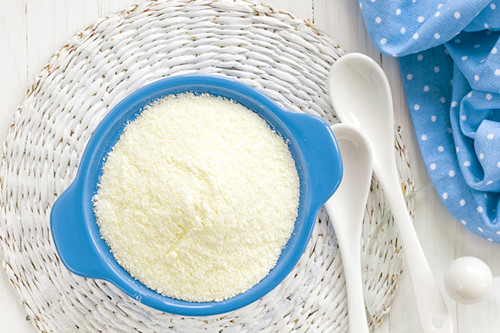What is hydrolyzed milk protein?
Hydrolyzed milk protein refers to a food ingredient obtained by hydrolyzing the milk protein in milk. Specifically, this involves breaking down whole proteins into smaller molecules—proteins, peptides, or amino acids—through heating and/or the action of substances such as acids and enzymes. This process reduces the allergenicity of the large protein molecules while maintaining a nutritional profile similar to that of the undecomposed proteins. Hydrolyzed milk protein can be divided into two types, namely hydrolyzed whey protein and hydrolyzed casein. Depending on the degree of hydrolysis, it can be further categorized into partially hydrolyzed whey protein, partially hydrolyzed casein, extensively hydrolyzed whey protein, and extensively hydrolyzed casein.

Application of hydrolyzed milk protein in infant formula foods
Currently, its application can be mainly categorized into the following two types:
Regular infant formula milk powder. It cannot claim to be suitable for infants and young children at risk of allergies, and there is no mandatory requirement for the amount of hydrolyzed milk protein in the formula;
Infant formula for special medical purposes. It is divided into three categories based on the degree of hydrolysis: partially hydrolyzed milk protein formula, extensively hydrolyzed milk protein formula, and amino acid-based formula. Each formula has specific requirements regarding the hydrolysis state of milk protein, and the product label can bear the claim of suitability for infants at risk of allergies.
The degree of hydrolysis varies by product type. Amino acid-based formula foods for special medical purposes (pure free amino acids) have the highest degree of hydrolysis, followed by extensively hydrolyzed formula foods, and partially hydrolyzed formula foods, while the degree in regular infant formula milk powder is the lowest.
The extent to which protein is hydrolyzed is directly linked to how well a product caters to different needs. Amino acid formula foods are best suited for infants with severe food allergies, offering maximum protection against allergic reactions. Extensively hydrolyzed formula foods are ideal for infants with mild to moderate food allergies, aiding in reducing allergic occurrences. Moreover, partially hydrolyzed formula foods are tailored to help prevent allergies in infants at high risk. Whereas the moderately hydrolyzed proteins in regular infant formula milk powder are intended to optimize the digestion and absorption process for the majority of babies. The reason behind this is that the post-hydrolysis protein molecules are smaller and more easily absorbed by the delicate digestive systems of infants, thus easing their gastrointestinal load.
In this article, CIRS Group primarily analyzed the application of hydrolyzed milk protein in regular infant formula milk powder. According to statistics gathered, currently, infant formula milk powder adding hydrolyzed milk protein registered under the new national standards mainly includes ShuBeinuo, XingFeiFan ZhuoYao, ZhuoRui, ZhenAiBeiHu from Feihe Group, ZhiZhenAi, TianShi, QuanShiAi from Junlebao, as well as AiBeKe, GuanLeXuan, KeRuiXin from Beingmate Group.
What materials should be provided for registration under the new national standard?
Enterprises using hydrolyzed whey protein in their formulas should pay close attention to the following information during the registration process:
1) Labeling of hydrolyzed milk protein
Hydrolyzed milk protein in the formula composition and dosage table in the application materials, as well as the ingredient list, should be indicated as “Hydrolyzed XXX”.
2) Quality specifications of hydrolyzed milk protein
Since there is no relevant national standard for hydrolyzed whey protein, companies can refer to GB 11674 to establish quality standards or specifications and conduct batch inspections. Melamine testing shall be carried out for milk-containing raw materials.
3) Information on the manufacturers of hydrolyzed milk protein
Hydrolyzed milk protein is typically a primary raw material in formula design. Companies need to conduct on-site quality and safety inspections of the manufacturers or suppliers, approved by quality and safety management authorities. The application materials should include basic information regarding the manufacturers and their registration information in China (for imports), among other details.
4) Source of raw materials for producing hydrolyzed whey protein
A statement on the source of hydrolyzed whey protein components shall be submitted, including sources of raw materials, animal sources, types, and sources of enzymes and donors, among others. It should also clarify the compliance and safety of the milk protein raw materials, and whether they are suitable for use in infant formula milk powder.
5) Compliance of enzymes used for hydrolysis with GB 2760
If enzymatic hydrolysis is employed, the types, sources, and donors of enzymes used in the hydrolysis process must comply with the provisions listed in Table C.3 of GB 2760 - food enzyme preparations and their sources.
S.N. | Enzyme | Source | Donor |
7 | Aminopeptidase | Aspergillus oryzae | |
10 | Protease (including milk clotting enzymes) | Cryphonectria parasitica (Endothia parasitica) | Cryphonectria parasitica (Endothia parasitica) |
Bacillus licheniformis | |||
Aspergillus niger | Aspergillus niger | ||
Bacillus amylolique faciens | |||
Bacillus amylolique faciens | Bacillus amylolique faciens | ||
Bacillus subtilis | |||
Cryphonectria parasitica (Endothia parasitica) | |||
Rhizomucor miehei | |||
Aspergillus oryzae | |||
Kluyveromryces lactis | Calf stomach | ||
Mucor pusillus | |||
Aspergillus melleus | |||
Geobacillus stearothermophilus (preciously known as Bacillus stearothermophilus) | |||
48 | Typsin | Porcine or bovine pancreas |
6) Measures for controlling the hydrolysis degree of hydrolyzed whey protein
Control measures for the hydrolysis process: Provide materials including the hydrolysis process flow diagrams, steps, main production control parameters, critical control points (CCPs), and methods for controlling the hydrolysis degree, among others. It should also be explained that all parameters are within the control range to ensure the consistency and controllability of the process reaction.
Indicators for controlling the hydrolysis degree: Provide specific quality specifications for hydrolyzed milk protein, including control ranges for various indicators such as degree of hydrolysis, pH value, molecular weight distribution, etc.
7) Controllability and safety of the degree of hydrolysis
Provide research materials related to the degree of hydrolysis with the applicable population and relevant clinical usage data to prove its safety. Additionally, details the product’s usage history, food safety-related customer complaints, product recalls, and other situations.
8) Historical data on the use of hydrolyzed milk protein in the formula
In case of the historical record of use, details regarding the quantity of hydrolyzed milk protein added to the product, production timelines, and output shall be provided. In addition, applicants shall also submit results from regulatory authorities’ routine supervision inspections, sampling tests, and system inspections concerning the quality and safety of the registered formula.
If you have any questions or need assistance regarding the registration of infant formula milk powder under the new national standards both at home and abroad, feel free to contact the Food Business Division at service@cirs-group.com.
Further information
Strategies for Enterprises in Response to New Infant Formula Registration Regulations in China

